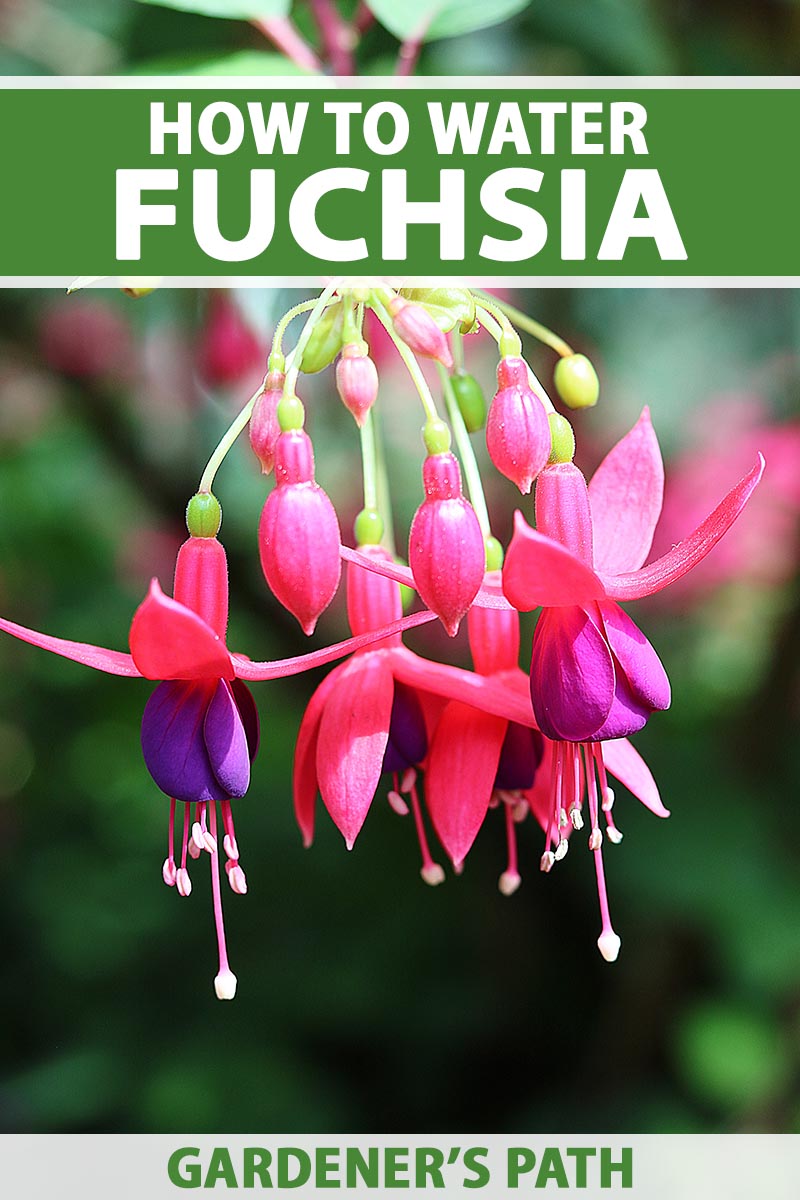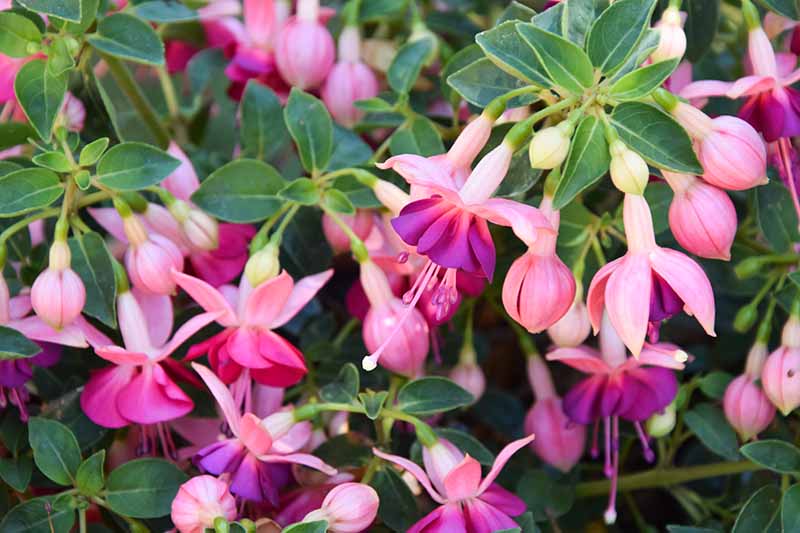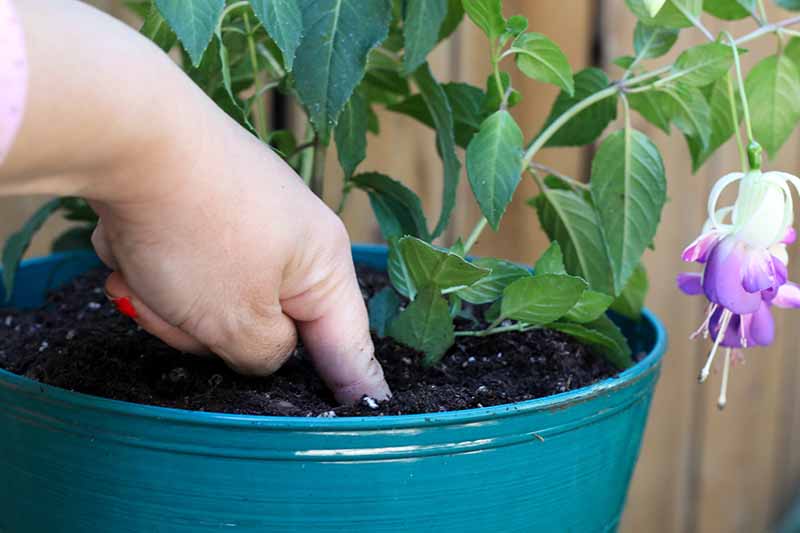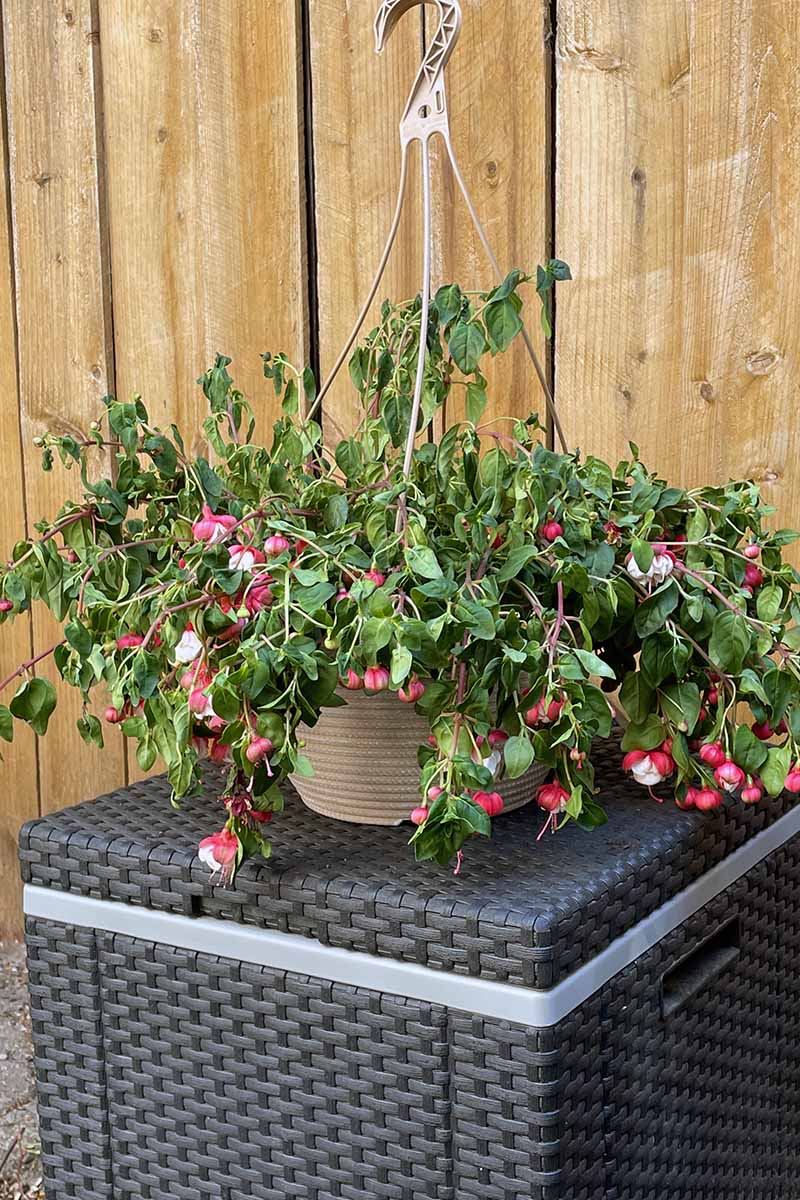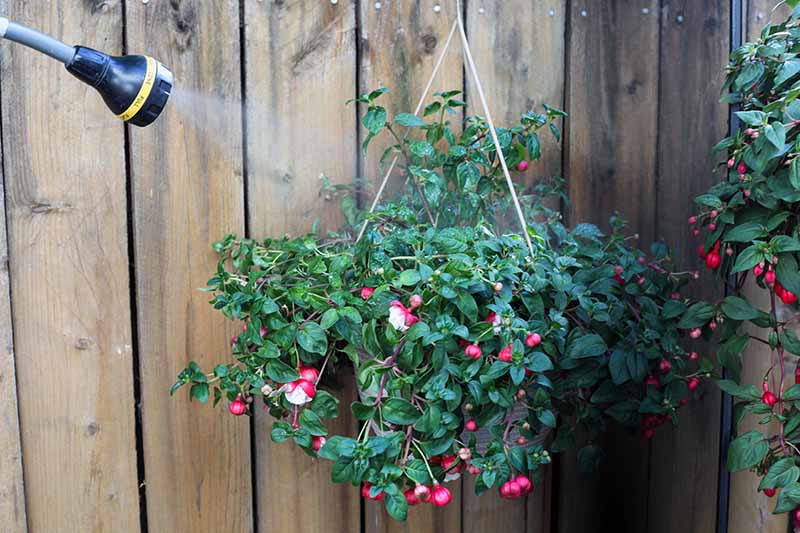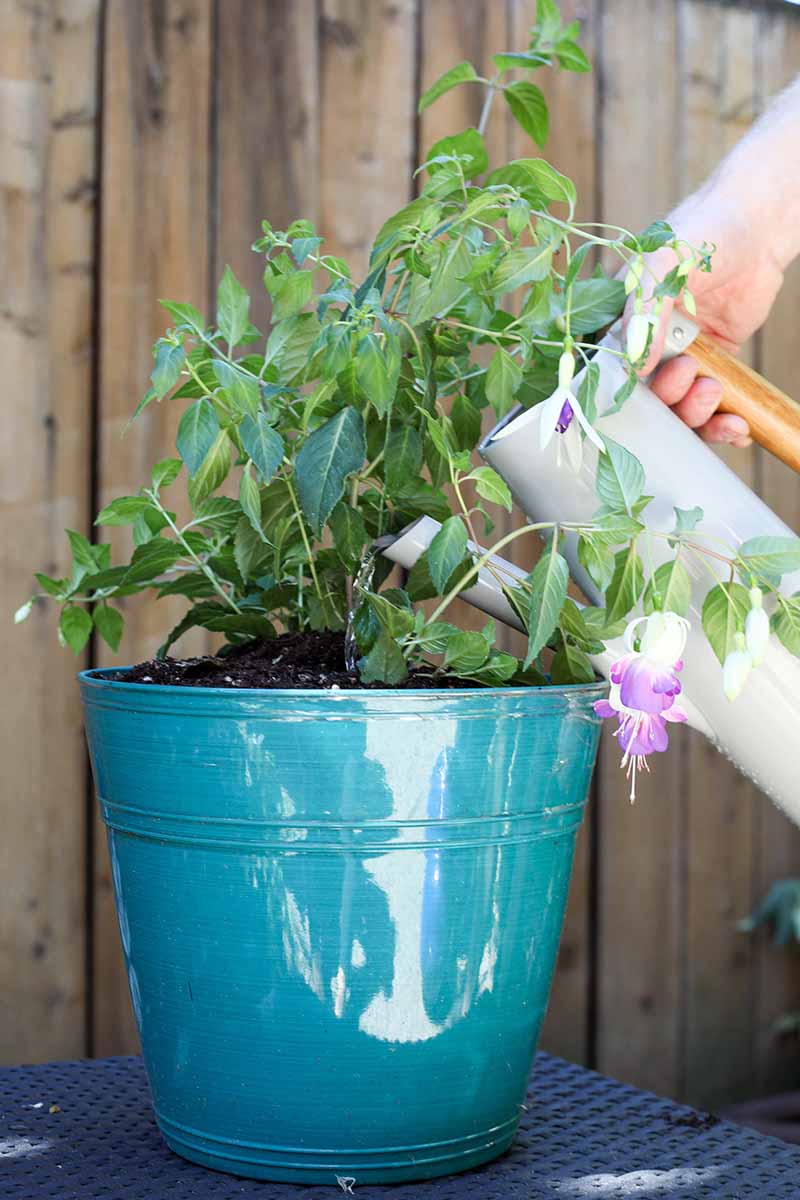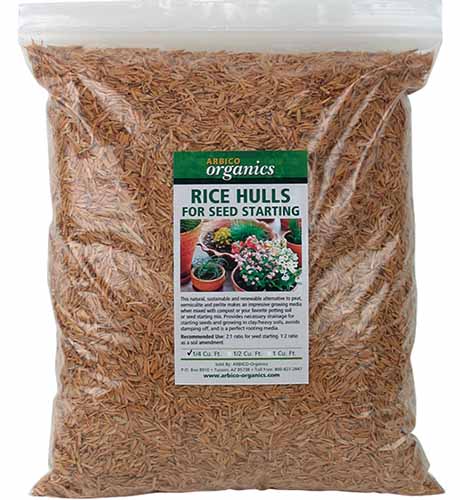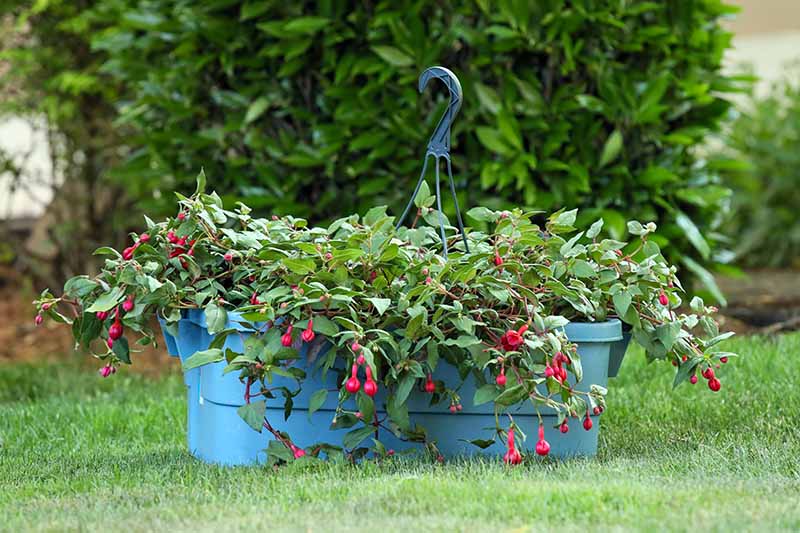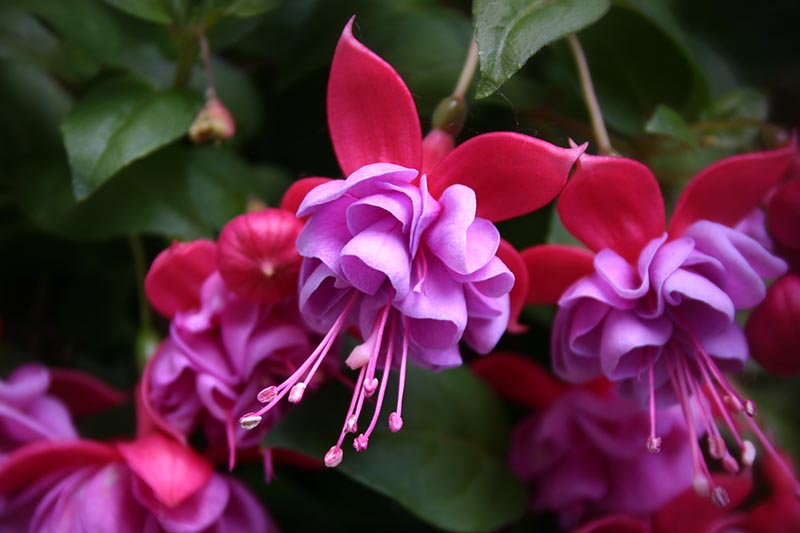If you happen to live in a mild climate with lots of rain, raising fuchsias will be relatively easy for you, since that’s the kind of environment these plants thrive in natively. That’s why they do so well in places like England and the Pacific Northwest. But if you live somewhere that’s significantly dry, hot, or otherwise less-than-perfect for these plants, you’re going to have to make an extra effort to give them what they need. We link to vendors to help you find relevant products. If you buy from one of our links, we may earn a commission. If you need a refresher on how to grow fuchsia flowers in your garden, check out our guide. Up ahead, here’s what we’ll discuss to help turn you into a fuchsia watering expert: Let’s get started.
When to Water
When’s the best time to water a fuchsia plant? When it’s dry, of course! The hard part is figuring out when precisely that is. In my early fuchsia growing attempts, every time I did wrong by one of these plants, it was because of my failure to give it the right amount of water. Maybe you can relate – I’ve never lost a fuchsia plant to improper sun exposure, diseases, or pests. In my case, it’s always about the moisture. It took me a few years to realize that, while these plants can handle full sun in lots of places (despite their reputation as a shade plant), they can’t handle dry soil. At all. I was trying to grow this fantastic flower in a hot, dry climate and I wasn’t irrigating it enough. Then I moved to a milder climate and I killed a few plants because I was giving them too much water. It was hard to break old habits. I couldn’t win! And what’s worse, I gather that this isn’t uncommon among fuchsia lovers, who will sometimes purchase a new hanging planter filled with these beautiful blooms each year, only to let it dry to a crisp before they toss it out, much like harvest mums or holiday poinsettia plants. But there’s no need to waste good plants, or to allow them to come to an untimely end. Now I know that while I can neglect the deadheading or even put them in a spot where they get a bit too much sunshine, the one thing I can’t neglect with fuchsias is giving them the right amount of moisture at the right time. The lesson here? Attentiveness to the moisture level in the soil when growing these gorgeous plants is key! For plants that are growing in the ground in an area that doesn’t get too hot, you might need to irrigate just once or twice a week. For a hanging plant in a hot area, it could be twice a day. In regions that see air temperatures above 70°F, you will need to be more diligent. Plants also tend to need more moisture in the spring and summer, and less in the fall and winter, though this can depend on the local climate as well. I find that the easiest way to know how my plants are doing on moisture is to simply put a finger down halfway into the soil. It should feel like a well-wrung-out sponge. If the soil feels dry, water it. If it feels like a soaking wet sponge, don’t water until it dries out a bit. You can also use a soil moisture meter if you want to avoid getting your fingers dirty. We have a guide to help you use these handy tools in your garden. Speaking of the soil, while it may sound pretty straightforward, fuchsia can be a challenging plant to water appropriately. It likes a lot of moisture but it can’t stand soggy roots. How to find a happy medium? Well, medium is the operative word here. Planting in appropriate soil makes a world of difference. If your ground soil is sandy or has a lot of clay in it, amend it with well-rotted compost to improve drainage and moisture retention. Potted soils can be amended with coco coir to do the same thing. Don’t wait until your plant is wilting before giving it a drink. At that point, it has already gotten too dry. Observing your plant to determine when it might need a drink can be confusing because the leaves will droop if the plant is too dry, or if the air temperature is too high around your plant – even if it has plenty of moisture in the soil. That’s because the plant stops transferring moisture through its leaves when the temps climb above 70°F. More than once, I’ve gone to add a little water to a fuchsia because it was drooping, only to find that the soil was still totally wet. If you were to add moisture at this point, it could potentially further stress an already stressed plant by waterlogging the roots. As botanist Dr. Peter Bay explained to the American Fuchsia Society in 2018, plant roots need oxygen to survive. When there is too much water sitting in the soil, the roots can’t breathe and plants suffocate, resulting in an untimely death. So what do you do if your plant is wilting but the soil is moist? Mist the plant to cool it and add moisture to the foliage. Hanging plants can be put on the ground in a shadier spot until they perk back up. And finally, what time of day should you unravel the hose? Morning is best. If you water in the evening, your fuchsia will push the excess out of its pores. That doesn’t sound like a big deal, right? But when the plant pushes water out of the pores in buds that are closed, this can create unsightly brown spots that are revealed when the flowers open.
How to Water
Now that you know when to water, how exactly should you give your plant the moisture it needs? First and foremost, as described above, you’re always going to check to see if the soil is dry. If you get enough rain in your area, you might not even need to add supplemental moisture to your outdoor plants. If your plants are growing in the ground, you can rely on irrigation via sprinklers or the hose, but be sure to keep an eye on how moist the soil is. This is where a soil moisture meter comes in handy, and you can also employ a rain gauge. It’s also worth noting that fuchsias are susceptible to fungal issues, which can be spread or made worse by excessively damp foliage. Watering at the soil level is always best. Add some organic mulch like straw or compost to the soil surface for plants growing in the ground to help retain moisture if you find the soil is drying out too quickly. For potted plants, add water slowly, using a hose or can. Don’t let it overflow over the sides of the container. You can also use drip irrigation. After a few minutes, empty any saucer or catchment that your plant is sitting on.
Tips for Watering Hanging Plants
Lots of stores sell fuchsia plants in hanging containers. While they’re beautiful, these containers make irrigation more of a challenge. Arbico Organics Rice Hulls You can purchase rice hulls at Arbico Organics in one, half, or quarter-cubic-foot bags. Not only do they tend to dry out fast, but they also overflow quickly when you water, so less of the wet stuff is reaching the roots. The plants are also usually tightly packed into the containers to make them look full and lush. It’s pretty, but this means the roots have less soil around them to retain moisture. To make sure your plant is getting the moisture it needs, lower the container into a bucket filled with water and allow the moisture to soak up through the bottom. This is called bottom watering, and we have a guide you might want to check out on how to do this gardening chore the right way. If you can’t or don’t want to use this method, provide water slowly, allowing it to drain out of the bottom without overflowing and running over the rim. You might need to stop for a few minutes to allow the soil to soak up the moisture and then add a little more. But fuchsias will let you know right away if they aren’t happy with the amount of moisture they’re receiving. And you’ll know pretty quickly if you’ve let things go for too long. If you chronically under water your plants, they’ll drop their flowers or might even die, and oversaturation can lead to root rot and other types of fungal disease. Yikes! But hopefully, this guide has given you the info you need to prevent that from happening. Instead of stressing your poor plants, they’ll be looking better than ever. If so, we’d love to hear about what kind of fuchsia you are (expertly) watering in the comments section below! And if you want to learn more about growing fuchsias in your home or garden, give these articles a look next:
How to Prepare Your Fuchsia Plants for WinterTips for Growing Fuchsia as HouseplantsHow to Grow Hardy Fuchsia Shrubs in the Home GardenHow to Harvest and Save Fuchsia Seeds
